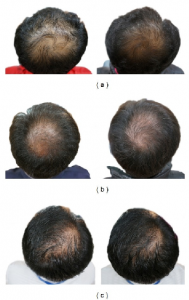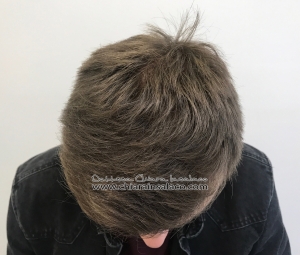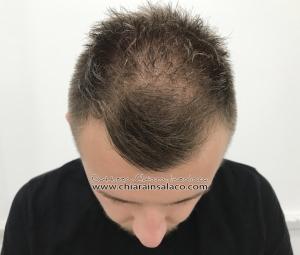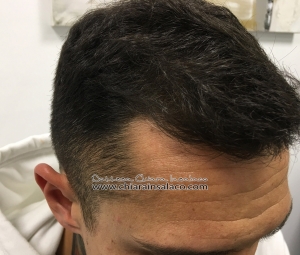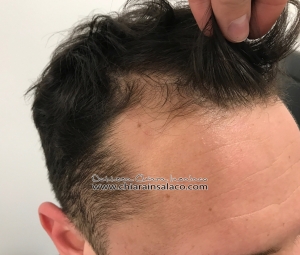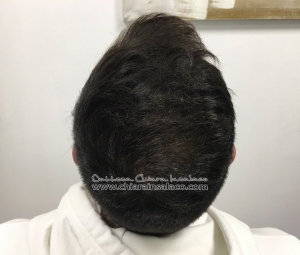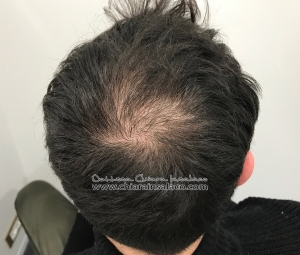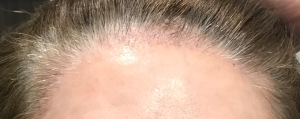This is very exciting article which shows that it can significantly improve communication and social skills in autistic adults.
Hi doctor, just a question, do you have hundreds of patients on Fin without any sides? And if they do have any do they just call you? And what dosage do you recommend, Im thinking of 0.25mg
I have thousands of patients on finasteride without side effects. Usually, I start at the recommended dose, unless the patient is unusually concerned about the sexual side effects. If that be the case, I might start with 1/4 dose and slowly over weeks increase the dose until it reaches the 1mg dose provided that there is no deleterious side effects reported.
I get a good family history and try to match the patient’s hair loss pattern with his family history. Then I mark where the patient is in his hair loss process, usually deploying the HAIRCHECK instrument test (https://baldingblog.com/haircheck-test-how-it-is-done-video/). Then I discuss the various options that are age related. Many of the men under 25, who may be balding and wanting a hair transplant, I discuss the need to delay such decisions and offer the various treatment options such a minoxidil and/or finasteride. Then I see the patient yearly to find out the effectiveness of the treatment and may make adjustments. Once the man has passed 25-26, I may or may not discuss the hair transplant option. Throughout this process, I develop a relationship with the patient so we get to know each other and I learn and understand who he/she is, what their concerns are and acting like a doctor, do the things that good doctors do, that show concern about the course that the hair loss undergoes during this period, year to year.
Assuming that you don’t have an infection because your doctor cleared this diagnosis, then your hair and skin color often produces sensitive skin. To find out if this is the cause, you can scratch your forehead with your fingernail by pressing it into your forehead and moving it about 2 inches. IF the scratch area stays red for more than a few minutes, you have Histamine positive response and may be able to treat your red recipient area with topical steroids. ?
That would not make sense to me. One or the other is the way to go. If the oral is working for you, don’t switch as the expense is considerably different.
This is a very impressive study on 76 men which took place over 24 weeks and got substantial growth. Mean hair count increases of 40% were observed in PSO-treated men at ‘just’ 24 weeks, whereas increases of 10% were observed in placebo-treated men (P < 0.001). Adverse effects were not different in the two groups. I think that this is worth a try for many men thinking about doing something simple and inexpensive for treating their hair loss.
Would my weight loss be due to a hormonal shift brought about by losing weight and thus speeding up the MPB?
I am not sure about the mechanism, but what you are suggesting is possible. Weight loss that is rapid often triggers male pattern balding but rapid weight loss itself, can cause hair loss in many people.
yes, finasteride can regrow hair in the front and mid-scalp, especially in the younger male.
Dr. Rassman’s Comments: I saw Dr. Insalaco present these findings at a meeting last month in the United Kingdom. About 200 hair restoration surgeons attended the meeting. Her results (combining Finasteride and minoxidil in a drug formulation) was very impressive, reversing hair loss in various parts of the scalp over an 18 month period of time. Patient compliance was high and what was most interesting was that there were no sexual side effects reported in her 300 test population. I was so enthusiastic about this, that I asked her to write a short article for this blog. Based upon her work, I will start prescribing it to my patients who request it. For more information on this, please read more info on Topical Finasteride Consultations.
Personal experience with Local Finasteride
Chiara Insalaco, MD, PhD
Plastic and Reconstructive Surgeon
Hair Restoration Specialist
Rome, Italy
Finasteride, a synthetic 4-azasteroid compound, is an antiandrogen which acts by inhibiting 5-alpha reductase. This enzyme converts Testosterone to Dihydrotestosterone (DHT). It works by partly blocking the body’s production of the male hormone that causes the prostate to enlarge and in those with genetic balding, it is the hormone that induces hair loss.
In December 22nd 1997, the FDA approved finasteride (Propecia®) to treat male pattern hair loss.
Clinical Studies for PROPECIA® (finasteride 1 mg) in the Treatment of Male Pattern Hair Loss shows that 3,8% of men experienced sexual adverse problems:
1.Decreased libido
2.Erectile Disfunction
3.Ejaculation Disorders
In 2011 the U.S. FDA conducted a post marketing evaluation of reported case of persistent sexual dysfunction after finasteride discontinuation. Of the 2527 cases, from 1997 to 2011, the FDA identified 59 reported cases of Sexual Disfunction (2.3% of cases) that lasted 3 or more months after Finasteride Discontinuation. FDA has required Merck to revise the Propecia label to disclose the post marketing sexual adverse events.
Shortly after Merck revised its label, THOUSANDS ( perhaps hundreds of thousands) of websites claim that Propecia and Finasteride cause erectile dysfunction and loss of libido; however, the drug has be used by millions of men, so that it was hard to connect the relationship when looking at the FDA 2.3% incidence of sexual side effects figure.
In Italy, in order to overcome the problem we came up with a new topical formulation
The aim was to achieve:
- Maximum absorption through the epidermal layer of the scalp
- Minimize the systemic absorption
The first study about topical finasteride is Italian and it was made in 1997: Mazzarella, G., Loconsole, G., Cammisa, G., Mastrolonardo, G. and Vena, G. (1997). Topical finasteride in the treatment of androgenic alopecia. Preliminary evaluations after a 16-month therapy course. Journal of Dermatological Treatment, 8(3), pp.189-192. The study was a single-blind, placebo-controlled, 16-month trial carried out in 52 patients with Alopecia Areata using a topical 0.005% finasteride solution. The results showed that the clinical outcome, in terms of both hair regrowth and balding areas reduction, seems to be encouraging, and it also showed an absence of either any evidence of percutaneous absorption of finasteride producing local/systemic untoward effects. In 1997 the FDA approved Propecia® to treat AGA so the study was forgotten!
There are few different compound formulations. They are not Over-the-Counter drugs which can be purchased without a prescription. Only few pharmacies in Italy are able to make it.
The most common for used in Italy is the Finasteride Liposomal Gel.? The liposomal vehicle has a high penetration capacity through the epidermis and it’s able to keep the drug locally in the skin for long time.
- It has a good aesthetic outcome
- It doesn’t make the hair greasy
This combination has results in good patient compliance
The Milan University evaluated 300 patients treated with the Finasteride Liposomal Gel.
The result: Systemic Absorption is limited to 1/18 compared to the Oral Finasteride dose of 1mg.
In my daily practice I combine both Minoxidil and Finasteride in the same lotion in order to have the maximum result. Before giving Local Finasteride I always request: (a) DHT (b) Testosterone levels and (c) Sperm Counts. So far none of my patients have shown any changes in these exams or reported any side effects.
There are new scientific studies showing that finasteride doesn’t cause Sexual Side Effects:
These studies suggest that:
- Men with Alopecia may be inherently more susceptible to sexual dysfunction regardless of treatment
- Sexual dysfunction is not uncommon in the general population regardless of alopecia status
Dr Chiara Insalaco
www.chiarainsalaco.com
Blood serum levels of DHT have no value in determining the effectiveness of finasteride.
Yes, some women can and maybe should take finasteride if they have Polycyctic Ovarian Syndrome and hair loss or Frontal Fibrosing Alopecia (an autoimmune disease which causes hair loss in women). It should NOT be taken by women who have hair loss and might get pregnant as it can cause fetal hermaphrodites which is a high risk for women taking finasteride when getting pregnant. See article here: https://www.mdlinx.com/journal-summaries/finasteride-hair-loss-hirsutism-dermatologic-alopecia/2019/02/06/7556054/?spec=dermatology
About this time last year my son lost forty pounds through diet and exercise. I started noticing some hair loss and we made an appointment. Primary doctor said it’s no big deal and the hair will come right back. Blood work came out fine. The hair loss started accelerating rapidly so we went to a dermatologist who said that the weight loss likely “triggered” male pattern baldness. She believes that he would have likely started losing his hair in five years or so, but the stress on his body kicked it into overdrive. She wanted to put him on finesteride (I said no), but he started minoxidil and some BS pills called Nutrafol. We went back to the derm three months later and hair was no longer shedding, but no regrowth. His hair is very diffused on top and even more so in the crown. I don’t know what to make of all this. I obviously don’t want him to go through this (it’s affecting his social life and anxiety), but putting him on fin seems dangerous. Is it possible to trigger male pattern balding or could this just be telogen effluvium?
Acute weight loss often causes hair loss and it can trigger MPB even in a 15 year old.
Page 276 of 635



